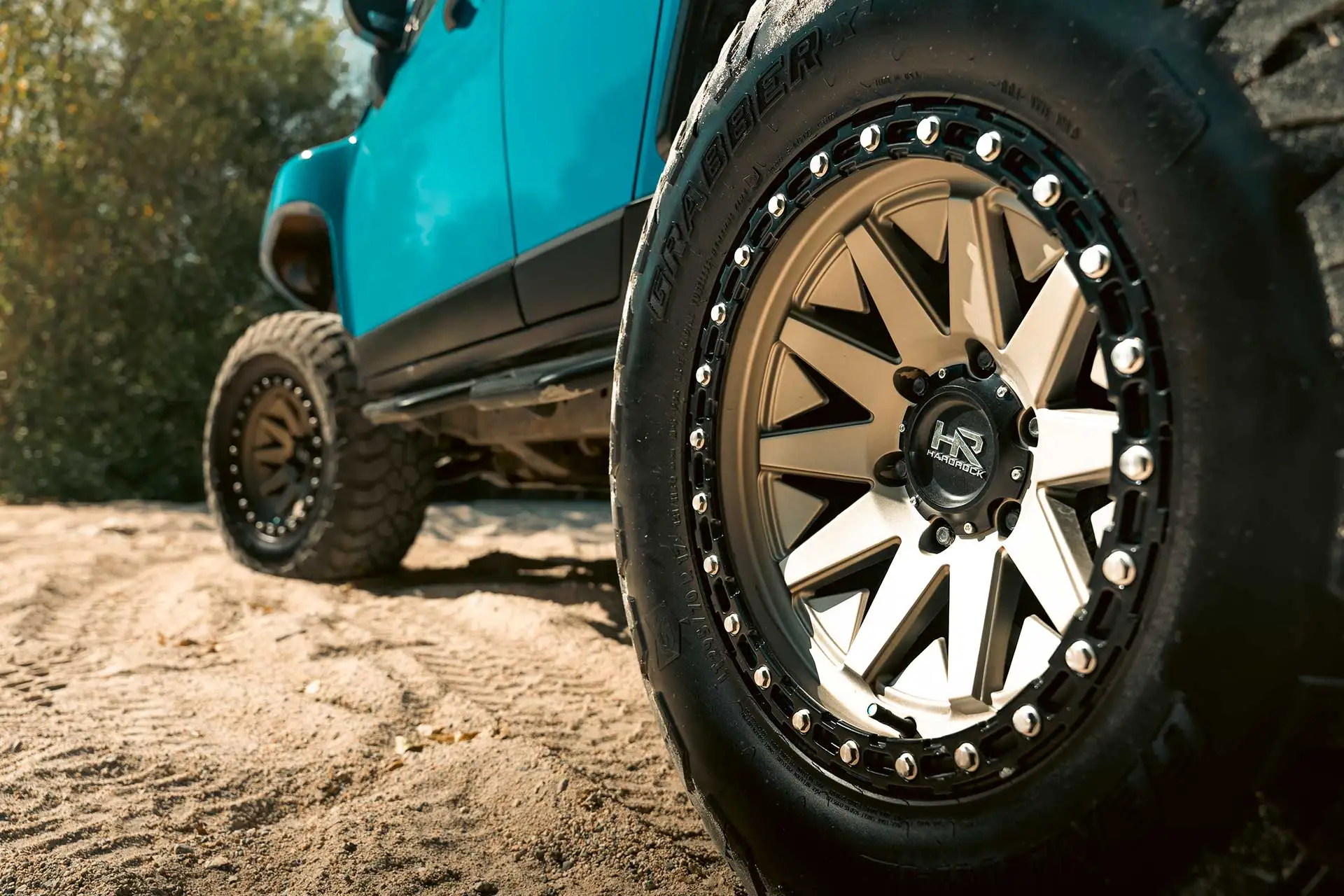Bolt Pattern Guide: Everything You Need to Know
Choosing the right set of wheels for your rig starts with understanding a fundamental measurement that determines whether your new wheels will even bolt onto your truck. Bolt patterns represent the very foundation of proper wheel fitment, and getting it wrong means you just bought wheels that don’t fit. Yikes. At Hardrock Offroad, we’ve built our reputation on providing enthusiasts with technical knowledge that brings your vision to life, whether you’re building a weekend trail warrior or a full-blown overland rig.
What is Bolt Pattern?
Bolt patterns create an imaginary circle dictated by the center points of each lug hole on your wheel. This measurement ensures your wheels mount to your truck’s hub, providing not only safe operation, but proper load distribution. This is especially vital when on the trails.
Bolt patterns follow a standardized format using two numbers: the first number indicates the number of lug holes, and the second specifies the diameter of the circle those lug holes create. So for example, a 6×5.5 bolt pattern means six lug holes arranged in a circle measuring 5.5 inches in diameter. This kind of measurement is super common for trucks and SUVs, but you may have also seen a number like 6×139.7. What the heck is that? Don’t panic, whether you see 6×5.5 or 6×139.7, they both describe identical bolt patterns. One is measured in inches, and the other in millimeters.
Wait, then what’s PCD? You’re not alone. PCD stands for Pitch Circle Diameter, and it represents the exact same measurement. Bolt pattern and PCD are interchangeable terms.
Understanding the Numbers
Like we covered above, the first number in any wheel bolt pattern specification tells us how many lug holes there are, while the second number tells us the diameter of the circle the lug holes make. Common configurations range from four lugs on smaller cars and up to eight lugs on heavy-duty trucks.
Truck bolt pattern specifications typically use larger circle diameters to better distribute load across a wider area, providing the much needed strength for towing, hauling, and aggressive off-road use. The common lug hole count for trucks and off-road capable vehicles is 6 or 8.

How to Measure Bolt Pattern
With so much information available on online resources, databases and forums for bolt pattern information, it’s understandable that self-measuring PCD seems a bit…prehistoric. That said, if you’re more of a hand-on type of person, knowing how to measure bolt patterns is not a bad tool to have in your arsenal.
A quality set of calipers delivers precise measurements, although a standard ruler also works. Even-numbered lug patterns like four, six, or eight-lug configurations follow a straightforward process: measure straight across from the center of one lug hole to the center of the directly opposite lug hole. This center-to-center distance gives you the bolt circle diameter.
Five-lug patterns require measuring from the center of any lug hole to the back edge of the farthest lug hole, then using a conversion chart to determine the actual bolt circle diameter. For a 5×5.5 bolt pattern, this measurement would be approximately 3.25 inches.
Double-check measurements by taking readings at different points around the circle. Consistent results confirm accuracy, while variations indicate measurement errors. The most common mistakes include measuring from lug hole edges rather than centers and mixing metric and imperial units.
Popular Off-Road Bolt Patterns
The 6×5.5 bolt pattern is the undisputed king in the off-road scene, making appearances on countless Chevy, Ford, Toyota, and GMC trucks. This PCD offers exceptional strength-to-weight ratio while unlocking a wide selection of wheels in every style and finish. Finding a wheel that fits a 6×5.5 bolt pattern is a cakewalk.
When moving up to HD trucks, the 8×170 bolt pattern is the most common. These heavy-duty applications demand the strength that only an 8-lug pattern can provide. This PCD handles extreme loads, off-roading abuse and heavy towing duties. You’ll see this configuration on the Ford Super Duty, RAM 2500, and Silverado 2500 HD.

5-Lug

6-Lug

8-Lug

Dual Drill
Popular Bolt Patterns By Vehicle
| Make | Model | Years | Bolt Pattern |
|---|---|---|---|
| Ford | F-150 | 1997–2003 | 5x135 |
| Ford | F-150 | 2004–2025 | 6x135 |
| Ford | F-250/F-350 Super Duty | 1999–2025 | 8x170 |
| Ford | Bronco | 2021–2025 | 6x135 |
| Chevrolet | Silverado 1500 | 1999–2025 | 6x5.5 (139.7mm) |
| Chevrolet | Silverado 2500/3500 HD | 2001–2010 | 8x6.5 (165.1mm) |
| Chevrolet | Silverado 2500/3500 HD | 2011–2025 | 8x180 |
| Chevrolet | Tahoe/Suburban | 2000–2025 | 6x5.5 (139.7mm) |
| Dodge RAM | RAM 1500 | 2002–2010 | 5x5.5 (139.7mm) |
| RAM | 1500 | 2011–2025 | 5x5.5 (139.7mm) |
| RAM | 2500/3500 | 2003–2025 | 8x6.5 (165.1mm) |
| Jeep | Wrangler JK/JL | 2007–2025 | 5x127 (5x5) |
| Jeep | Grand Cherokee | 2011–2025 | 5x127 (5x5) |
| Jeep | Gladiator | 2020–2025 | 5x127 (5x5) |
| Toyota | Tacoma | 2005–2025 | 6x5.5 (139.7mm) |
| Toyota | Tundra | 2007–2025 | 5x150 |
| Toyota | 4Runner | 2010–2025 | 6x5.5 (139.7mm) |
Bolt Pattern Conversion Chart
The bolt pattern chart below shows PCDs in millimeters converted to inches, making your wheel shopping experience as smooth as possible.
5‑LUG
| Millimeter | Inches |
|---|---|
| 5x100mm | 5x3.94 |
| 5x108mm | 5x4.25 |
| 5x112mm | 5x4.41 |
| 5x114.3mm | 5x4.50 |
| 5x115mm | 5x4.53 |
| 5x120mm | 5x4.72 |
| 5x120.65mm | 5x4.75 |
| 5x127mm | 5x5.00 |
| 5x130mm | 5x5.12 |
| 5x135mm | 5x5.31 |
| 5x139.7mm | 5x5.50 |
| 5x150mm | 5x5.91 |
6‑LUG
| Millimeter | Inches |
|---|---|
| 6x114.3mm | 6x4.50 |
| 6x115mm | 6x4.53 |
| 6x120mm | 6x4.72 |
| 6x127mm | 6x5.00 |
| 6x132mm | 6x5.20 |
| 6x135mm | 6x5.30 |
| 6x139.7mm | 6x5.50 |
8‑LUG
| Millimeter | Inches |
|---|---|
| 8x139.7mm | 8x5.50 |
| 8x165.1mm | 8x6.50 |
| 8x170mm | 8x6.69 |
| 8x180mm | 8x7.09 |
| 8x200mm | 8x7.87 |
What Bolt Pattern is My Truck?
Figuring out what bolt pattern your truck uses is very easy. Here’s a few ways to check the PCD of your truck:
- Check your owner’s manual
- Manual measurement
- Check wheel-size.com
- Check an existing wheel on your truck, usually stamped in the back
The easiest way by far is to search online. The internet is packed with valuable information about your specific vehicle’s bolt pattern; from dedicated forums to online wheel and tire databases.
Top Wheel Picks
Fitment Considerations and PCD Solutions
Matching your PCD precisely is critical in off-road applications where wheels go through extreme loads that you don’t experience on paved roads. Hub-centric mounting provides superior strength by centering wheels on the hub, versus a lug-centric setup that relies completely on lug tension.
Sometimes you’ll see people wanting to run “incompatible” bolt patterns, and they’ll run adapters to make wheels fit. This is common in the off-road and truck world. That said, we don’t recommend running adapters on anything that drives on mud, dirt, sand, etc due to safety considerations and warranty issues.
If you do decide to go down the adapter route, be sure to get them professionally installed with proper torque specifications. The safest approach by far is just buying wheels with your vehicle’s correct PCD, ensuring maximum reliability.
Torqued Down
Mastering the fundamentals for bolt patterns turns your wheel shopping experience from guesswork to precision. The 6×5.5 and 8×170 bolt pattern represent the most common configurations in the off-road world, offering extensive wheel selection and proven reliability. What’s the next step? Understanding offset, backspacing and center bore specs to achieve the perfect fitment.
Ready to find the perfect wheels for your build? Checkout our complete wheel collection designed specifically for off-road and heavy-duty applications, backed by our technical expertise and commitment to help you build the ultimate rig.

